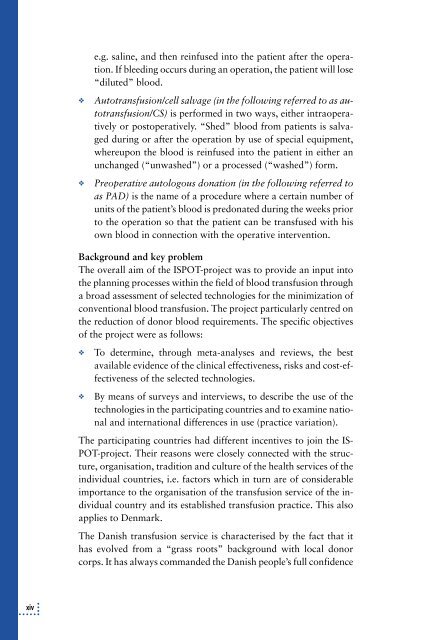Elektronisk udgave - Sundhedsstyrelsen
Elektronisk udgave - Sundhedsstyrelsen
Elektronisk udgave - Sundhedsstyrelsen
Create successful ePaper yourself
Turn your PDF publications into a flip-book with our unique Google optimized e-Paper software.
xiv<br />
e.g. saline, and then reinfused into the patient after the operation.<br />
If bleeding occurs during an operation, the patient will lose<br />
“diluted” blood.<br />
❖ Autotransfusion/cell salvage (in the following referred to as autotransfusion/CS)<br />
is performed in two ways, either intraoperatively<br />
or postoperatively. “Shed” blood from patients is salvaged<br />
during or after the operation by use of special equipment,<br />
whereupon the blood is reinfused into the patient in either an<br />
unchanged (“unwashed”) or a processed (“washed”) form.<br />
❖ Preoperative autologous donation (in the following referred to<br />
as PAD) is the name of a procedure where a certain number of<br />
units of the patient’s blood is predonated during the weeks prior<br />
to the operation so that the patient can be transfused with his<br />
own blood in connection with the operative intervention.<br />
Background and key problem<br />
The overall aim of the ISPOT-project was to provide an input into<br />
the planning processes within the field of blood transfusion through<br />
a broad assessment of selected technologies for the minimization of<br />
conventional blood transfusion. The project particularly centred on<br />
the reduction of donor blood requirements. The specific objectives<br />
of the project were as follows:<br />
❖ To determine, through meta-analyses and reviews, the best<br />
available evidence of the clinical effectiveness, risks and cost-effectiveness<br />
of the selected technologies.<br />
❖ By means of surveys and interviews, to describe the use of the<br />
technologies in the participating countries and to examine national<br />
and international differences in use (practice variation).<br />
The participating countries had different incentives to join the IS-<br />
POT-project. Their reasons were closely connected with the structure,<br />
organisation, tradition and culture of the health services of the<br />
individual countries, i.e. factors which in turn are of considerable<br />
importance to the organisation of the transfusion service of the individual<br />
country and its established transfusion practice. This also<br />
applies to Denmark.<br />
The Danish transfusion service is characterised by the fact that it<br />
has evolved from a “grass roots” background with local donor<br />
corps. It has always commanded the Danish people’s full confidence

















